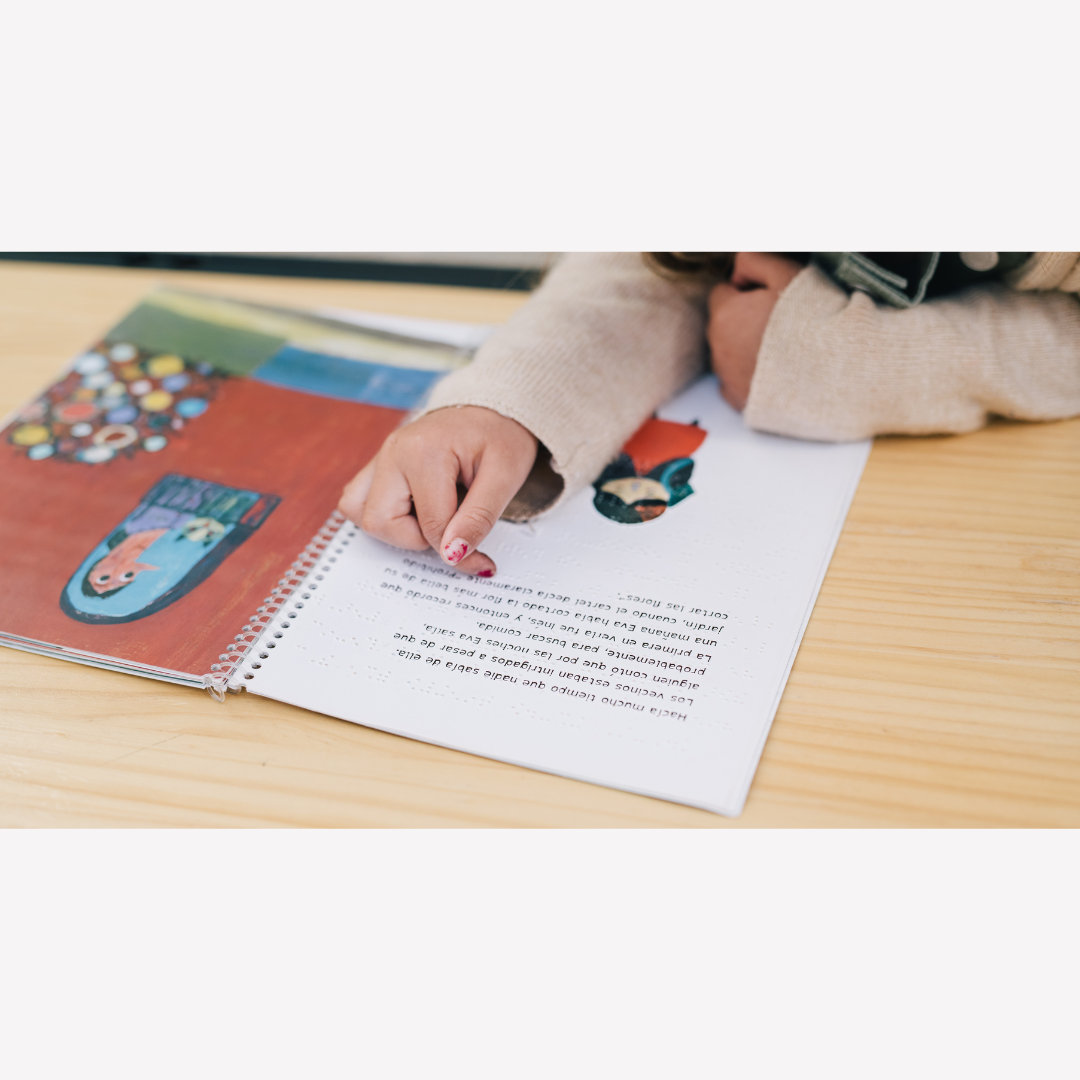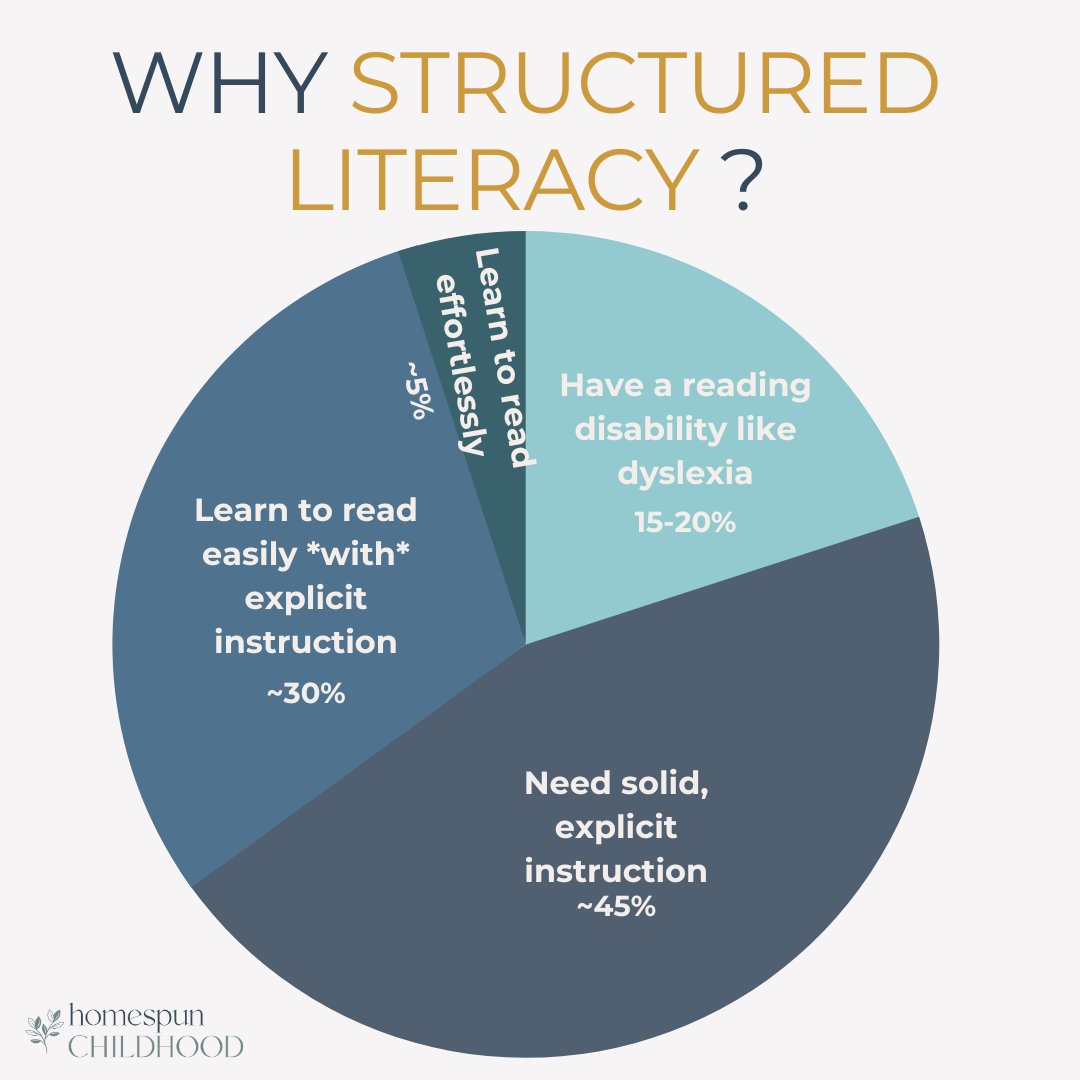supporting a struggling reader
Sometimes, social media makes homeschooling and teaching reading look like a walk in the park. Just surround them with beautiful books and read to them a lot, and everything will be just fine! Or maybe they just aren’t “ready” yet, and we should wait until they are.
Here’s the thing. Some children, roughly 15-20%, will struggle with learning to read due to a reading disability, like dyslexia. That’s 1 in 5 people. Another 40-50% of children need structured literacy — systematic, explicit instruction. Approximately 35% of children learn to read easily with systematic instruction. And only 5% of children learn to read on their own (Score, 2020). Let that sink in.
Children need high-quality, structured literacy instruction. And you can do it.
Many factors can contribute to why a child is struggling. Ultimately, though, we can take the same approach to help most children.
Assess: In order to help a struggling child, we need to know exactly what skills they have mastered, what skills they need to review, and where to begin (or restart) instruction. Sometimes, this is obvious; other times, it might not be so clear. I offer a Literacy Assessment Course for Homeschoolers for just this purpose. The course teaches you how to assess your children and make sense of the results.
Evaluate Your Current Approach: Are you using an evidence-based program? There are a ridiculous number of homeschool reading programs available. Some are better than others. Some very popular programs, such as TGTB, do not follow evidence-based practices. Check out my post on Structured Literacy for a breakdown of what to look for in a reading program.
Consider Your Pacing: Sometimes, even if you are using an evidence-based program, it is hard to know what your pacing should look like. Should you do one lesson per day? One lesson per week? This can vary dramatically from child to child. I always recommend starting much slower than you think and adjusting your pacing from there. Generally speaking, I recommend starting with one phonogram per week — so you would spend an entire week on the letter m and sound /m/ or the digraph sh and sound /sh/. Now, if you have a child who already knows all their letters and sounds (26 letters, short vowel sounds) and are beginning a program like All About Reading, you could move a bit faster — maybe 1 AAR lesson per week. If you are working with an older student, this is where the assessment piece is critical. Once you determine the skills they need to review, you begin instruction there — maybe reviewing a couple of phonograms a week. Then, when you get to the beginning instruction part, you drop to one phonogram per week. Many children, especially struggling readers, need additional time to master a phonogram and map it to their long-term memory. If you are unclear on how to teach one phonogram for an entire week, I go into this in detail with video examples in my Foundational Reading Instruction course.
Select Appropriate Instructional Strategies: Some structured literacy programs offer a lot of support and a variety of instructional activities (Pinwheels has the most support/activities, IMO). Other programs, while evidence-based, do not offer enough “extra” resources for children who need additional practice and support. There are many instructional activities you can add to your evidence-based program to help reinforce skills and develop fluency:
Phoneme-Grapheme Mapping
Word Chaining
Fluency Drills
Copywork/Dictation
Word Sorts
Phonological Awareness: Many struggling readers, especially students with dyslexia, have weak phonological awareness skills. We can support these students by adding phonological awareness instruction. Check out this free assessment to see if your student struggles with phonological awareness, and consider these resources.
Equipped for Reading Success by David A. Kilpatrick (Best overall pick)
The Intensive Phonological Awareness Program by C. Schuele
Phonemic Awareness in Young Children by Marilyn J. Adams (Good for pre-k - early elementary)
Guides
I developed my Literacy Assessments for Homeschoolers Guide to help homeschool families identify what skills their student(s) has mastered, needs to review, and where to begin instruction. I have a relaunch of my Foundational Reading Instruction Course coming soon, so make sure you are signed up for my newsletter for announcements.
So, let’s walk through a few common scenarios I see in my DMs and literacy consulting work:
Situation 1:
A parent is concerned about a younger sibling’s reading progress. They used TGTB with their older child, which worked great, but their 8-year-old is struggling. They do okay during the lessons, but the skills do not carry over from week to week. The child reads sound-by-sound or guesses words based on the pictures.
Recommendation:
Switch to an evidence-based structured literacy program. If you are unsure where to begin instruction, consider my Literacy Assessment course, which walks you through assessing your child’s literacy skills to determine where to begin instruction. Quickly review skills the child has mastered to set up the new program. Then, transition into a routine of introducing one new phonogram a week. Adjust pacing as needed.
Situation 2:
A parent is concerned about a 9-year-old’s reading fluency. They began reading instruction at 7.5 years old, completing Logic of English Foundations A-D. However, the skills don’t seem to be transferring over to books the child selects.
Recommendation:
Begin with basic literacy assessments to determine where the child is with their reading progress. Make observations about the child’s fluency. Do they sound out most words going sound-by-sound? Do they read fluently at the word level but very slowly? Are they skipping words? Do they rely on context or picture clues to read unknown words?
If the child has a strong knowledge of the phonograms taught in LoE and can apply the skills to read words out sound-by-sound, then you would want to focus on word-level fluency. You can do this through successive blending, word chaining, and fluency drills. If the child can read most words at the word level fluently but struggles with multisyllabic words and reading sentences with a natural pace and prosody, practice breaking down multisyllabic words before reading them in a connected text (like a passage or book). I have a syllable division resource here. Also, practice fluency drills, giving the student more opportunities to read the same passage before moving on. Slow down to one phonogram/week and consider implementing a review period to review previously taught phonograms.
Situation 3:
A 9.5-year-old child recently began formal reading instruction. Initially, the parents followed an approach of waiting for the child to be ready for reading instruction. However, they became considered and switched approaches. The child began with TGTB, but feels like the program is too babyish, and the parent is concerned about making up for lost time.
Recommendation: Consider a program like UFLI Foundations, Recipe for Reading, or adjusted Pinwheels. I have worked with many clients in a similar situation and have found UFLI to be the most straightforward program to implement that also honors the child’s age/development. If you suspect dyslexia or dysgraphia, it is worth considering Pinwheels as it is more comprehensive; however, you will likely need to make many adjustments. You can grab my UFLI for Homeschoolers Guide here.
If you feel overwhelmed by this task or would like assistance making a literacy plan, I offer literacy consulting, where I work one-on-one with families to create a plan based on their unique needs.





